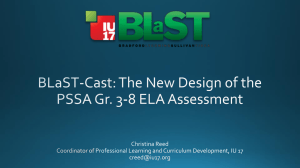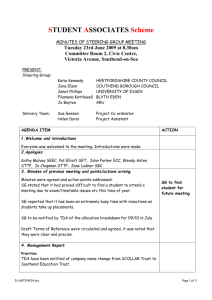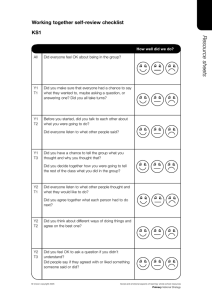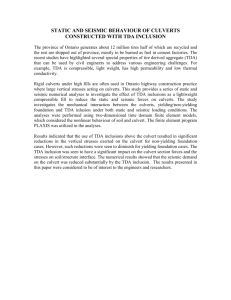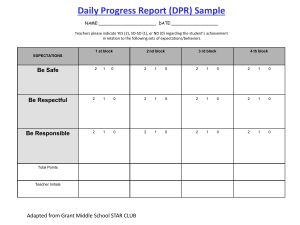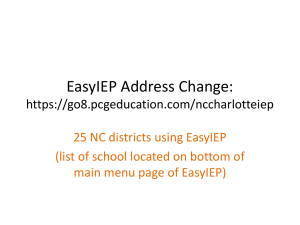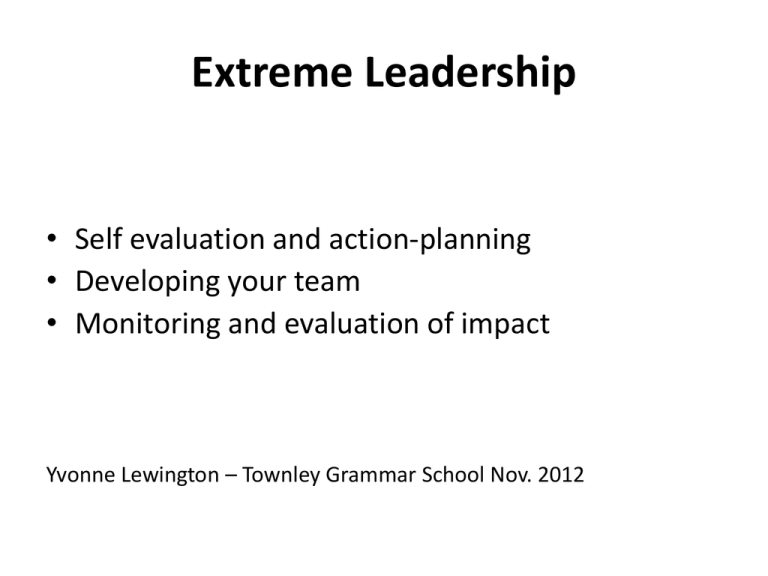
Extreme Leadership
• Self evaluation and action-planning
• Developing your team
• Monitoring and evaluation of impact
Yvonne Lewington – Townley Grammar School Nov. 2012
Leadership
isn’t meant to
be safe…
But it
should be
considered!
Promoting outstanding teaching
and learning
Know what you want.
Find out where you are.
Identify the gaps.
Address them.
What should you be looking for?
Ofsted cardsort
Divide the cards into two groups according to
which aspects of teaching and learning are easy
to evidence and which are more difficult.
Which are going well?
Which are not going well?
Which are a bit iffy?
What is your gut feeling about the
quality of T&L in your dept.?
Why?
Monitoring and evaluation
What strategies do you use to guide that “gut
feeling”?
Monitoring and evaluation strategies
On the list given, identify which strategies you use.
Draw this quadrant on a flipchart and assign them to
sections.
High impact
Low impact
Quick to do
Takes a lot of time
Evaluation not narrative
Read through the sample of a school self
evaluation.
How evaluative is it?
Can you see what is having an impact on
learning and progress?
Sutton Trust Report
Toolkit Of Strategies To Improve Learning
Summary For Schools Spending The Pupil Premium
By
Professor Steve Higgins, Durham University
Dr Dimitra Kokotsaki
and
Professor Robert Coe,
CEM Centre,Durham University
May
2011
http://www.suttontrust.com/research/?&p=2
Evaluating quality of feedback
Feedback quadrant – 10 minute book scrutiny
Action planning
Be incisive.
Check
hypotheses
Act
Review
TDA toolkit
Little book of managing change
www3.hants.gov.uk/tda_little_book_of_change.pdf
http://webarchive.nationalarchives.gov.uk/2010020212
0401/http://tda.gov.uk/remodelling/managingchange/t
ools.aspx
What’s working/so-so/not so brown paper
Quality V. menu ParentalSwift & easyCommunity
Childcare activities support referral
access
What’s
Working?
Quick wins
What’s
working
So-so?
Not so well
19
Challenges
1.
2.
3.
4.
5.
6.
1. With your team – ask everyone to write on
notes what they think is working, not
working, and is so-so, and stick them on the
chart.
N.B
Things can be noted more than once and
everyone’s viewpoint is accepted. There must be
no judgment at this stage.
Prioritise
Using different matrices for different purposes
Use Matrix I to help shortlist a number of issues to address;
Use Matrix II for selecting the most favourable options or
alternatives.
High
Higher
Priority
Issues
4
3
I
Impact
2
Low
Weak
2
3
4
Desirability Strong
We identify priority issues by rating the
impact they would have if they were
addressed and rating how compelling the
desire for change is
Used during the DISCOVER stage
Most
Favourable
Options
4
3
II
Impact
2
Low
1
1
22
High
1
1
2
3
Difficult Do-ability
4
Easy
We identify most favourable options or
alternatives by rating the impact they
would have if they were implemented
and rating how do-able they are
Used during the DEVELOP stage
The five whys helps us to understand all the causal factors
that condition a challenging issue
Staffing very stable
Staffing costs
86% of the
budget.
Costs too
high
Why?
Premises cost
costs
8.5%
Revenue
budget
not
balanced
Why?
Etc.
Income heavily
reliant on LEA
formula
Income
too low
Why?
Schools
facilities are
underused
23
Teachers are 70%
Why?
Low number of
TAs
Premises staff
cost 3.5%
Why?
Large number of management points
Teachers used to support pupils with SEN
Historic
Employ own cleaning staff at high rates
Cleaners local people with strong
connection to school
5-year routine
maintenance plan
undercosted
Have allowed some queue jumping
Beacon school
funding not
renewed
School decided not to reapply 2 years ago
LEA uses January
PLASC for Fair
Funding formula
Roll drop in January
Plan still has 3 years to run
Co-ordinator’s salary now in main school
budget
Knock-on impact in other areas, eg. FSM, SEN
Greater variety of facilities available
New Council sports
centre opened
locally
School not
used for
external
events
LEA cut back on community use of school
Health and safety issues
Governing body have stopped s/keeper
overtime
Problem solving, team building (PSTB)
What is it?
• It is first and foremost a structured approach to problem solving
• One of its greatest strengths is that the “Owner” of the issue will walk
away with an action plan
When would you use it?
• Whenever you have an issue or problem that requires a team solution
• Whenever you require a rigorous process to address an issue
• Use at the development stage after deepening the problem first with
Fishbone Analysis and/or Five Whys
24
PSTB – Problem solving, team building
Are there any rules?
• Not rules per se – just good team behaviour that needs to be
emphasised
•
•
•
•
•
•
•
•
•
•
25
Headlining, ie. keep the discussion at the right level
No idea is a bad idea
Be open-minded
Listen as well as contribute
One at a time
Participate actively
Don’t kill the process
Agree the time contract (eg. 20, 30 or 45 mins)
Remember who owns the problem
Clear roles and responsibilities maintained – owner, facilitator,
resources
Roles, responsibilities and rules
Facilitator
• Focused on
Owner
• Decision
maker
• Owns the problem
•
and goes away
with an action plan
Focused on
content
Team
• Contribute ideas
•
•
26
and expertise
Follow the
process
Help the team
attain the goal
the process
• Keeps the
meeting on
track
• Promotes
creativeness
How is the tool used?
The process has seven steps for the team to work through; this is a 30-minute example…
Problem
Statement
Background
Idea
generation
Idea
selection
Analyse
benefits &
concerns
Work any
critical
concerns
Action
planning
5
27
10
15
minutes
20
25
30
8. Review
1. Evaluate
7. Evaluation
2. Hypothesise
6. Timescale
3. Identify cause
5. Assign
4. Distil and
evaluate
actions and
impacts
David Rock - SCARF model
https://www.youtube.com/watch?v=5Wu33SdjeCs
S.C.A.R.F.
• Status
•
•
•
•
Certainty
Autonomy
Relatedness
Fairness
Resources
www.fromgoodtooutstanding.com/townley


